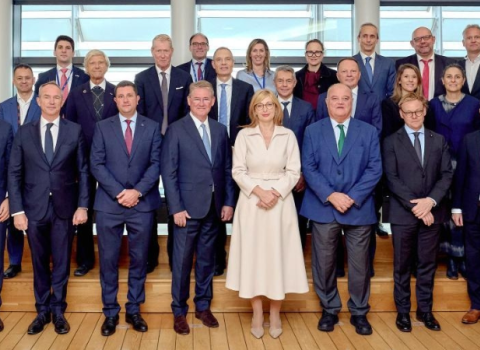A grace period could be the saving grace of European innovators who inadvertently disclose their inventions before filing a patent. But it would also create legal uncertainty for all users of the patent system

A statue commemorating Herb Boyer and Bob Swanson, co-founders of the first biotech company Genentech. The company’s US patents on transgenic organisms were filed during a grace period
The European Patent Office (EPO) has been looking again at the need for a grace period in the European Patent Convention. Last month it published the results of a survey that found only a small minority of its users would take advantage of such a mechanism, but also that the lack of a grace period is stopping universities from commercialising some of their research. As a result, Europe may be missing out on lucrative new products, start-ups, and even potential unicorns.
A grace period allows an invention to be disclosed, for instance in a scientific publication or conference paper, without undermining its novelty as far as a future patent is concerned. The US has a grace period, as do Japan and Korea, but Europe does not. This lack has been a matter for discussion for decades. Science|Business made its own contribution to the debate with a survey of European technology transfer offices, published in 2013.
The new EPO survey, conducted in the winter of 2021 - 2022, estimates that 7.8% of applications from European universities and 3.7% from public research organisations (PROs) over the previous three years were prevented by a pre-filing disclosure. Where this happened, 71% of universities and 51% of PROs reported that further development or commercialisation of the invention stopped.
The survey report does not translate this into a number of inventions, but the EPO was happy to provide a calculation. For the pooled category of European research organisations (universities and PROs), it can be deduced that around 250 European patent applications in 2021 were prevented from filing because of a pre-filing disclosure. “This means in turn that the development or commercialisation of the invention was prevented in about 177 (71%) of these cases,” said Yann Ménière, chief economist at the EPO. “It is also important to bear in mind that these are typically high-potential inventions stemming from cutting-edge scientific research.”
The other category of European patent users who had trouble with pre-filing disclosure was US companies, where 7.2% of applications were prevented, with 27% of these reporting a stop to commercialisation or development. Only 1% of applications from European SMEs were troubled by pre-filing disclosure, and 0.8% of other European companies. Overall, only 6% of all users said they would take advantage of a grace period, if it existed in Europe.
University attitudes
Europe’s universities are keenly aware of the problem of pre-filing disclosure. “A prior disclosure will basically kill the possibility to file a patent application and further commercialisation in several fields, because a patent is the instrument to provide a certain degree of exclusivity to either the owner or the licensee,” said Andrea Crottini, head of the Technology Transfer Office at the Ecole polytechnique fédérale de Lausanne (EPFL).
Those fields include pharmaceuticals, medical devices and the mechanical sector. “It is easier to define the sectors where patents are less relevant, and that is mainly software,” Crottini said. “It is almost impossible to protect the concepts behind software, especially when they are abstract.”
Without a patent to protect exclusivity, there is little reason for someone to invest in an innovation. “A pharma company will probably not invest in a compound in which there is no exclusivity. That investment can mean hundreds of millions of dollars for a pharmaceutical compound,” said Crottini. The same goes for start-ups. “Apart from the software business, investment is much more difficult for companies that have no exclusive rights to offer to investors.”
The main solution at present is continually educating researchers about the need to protect what they have. “Patenting and publication are 100% compatible, on condition that first we file a patent, and then we publish. It can even happen on the same day, but not the other way around,” said Crottini. Problems arise when people forget, or are not used to patenting. This is where a grace period could be useful. “At EPFL we do file a certain number of patents only in the US, because there is the grace period after prior disclosure, so of course we would be happy if this was extended to Europe.”
Others think the case for a grace period is less strong. “It would not be harmful for us, as a university, and it might even be good as a fall-back position,” said Marco Mank, patent manager at Friedrich-Alexander-Universität Erlangen-Nürnberg (FAU). “But we are also used to the fact that there is no grace period in Europe. It’s not a problem at all, and we only rarely have any trouble [with prior disclosure].”
His colleague Christoph Heynen, head of spin-off services and entrepreneurship at the university, agreed. “It might help in certain situations, but with regard to start-ups and commercialisation with industry partners, up to now it has not been such an important problem.”
Behind this is a cultural shift within academia when it comes to patenting. “Ten years ago, we had more discussions about possible time conflicts with regard to publication and patenting, but now many of those professors and other scientists are eager to exploit their intellectual property, and a bit better educated with regard to this issue,” Heynen said. “It’s more of a problem for inexperienced researchers, so a grace period might be more useful for PhD students or post-docs who are not that used to patenting.”
A far stronger argument for a European grace period is that it would harmonise the European system with the US, Japan and others. But then the grace periods would have to be exactly the same. “It’s already very complicated to get a European patent granted and a US patent granted to the same extent, so it would be even more complicated if the grace periods did not line up,” Mank said.
Risks and benefits
Universities also see risks in the adoption of a grace period. For example, it might save a patent application from researchers’ own disclosures, but not disclosures by other groups working in the same area, which may happen while a grace period is running. “So, there are cases where we would like a grace period, but we also need to be careful,” Crottini said. “It should be a fall-back position, and we should not get into the habit of publishing first and then filing a patent later.”
There is also a feeling that a patent based on a prior disclosure may be weaker than one that makes the disclosure. “A scientific publication is not the same as a patent application, with all the fall-back positions and safeguards written in by the patent attorneys,” Mank said. “In a paper, you maybe don’t disclose such fall-backs, and that is weaker than the solid priority data that is written into a patent application.”
Where those kinds of uncertainties exist, it would be usual for a start-up to file further, stronger patent applications to secure its position as it moves into the market. But there could still be situations where that is not possible, and a grace period might prove useful. “You might expect that having a grace period might have a positive influence on very basic platform patents. These kinds of patents are the kind that could be prevented [by prior disclosure] right now in Europe, because we don’t have a grace period,” Heynen said.
The most famous example of a grace period saving a platform patent is the Cohen-Boyer patent, on the process that first made possible the creation of transgenic organisms. After publishing their research in 1973, Stanley Cohen and Herbert Boyer were finally persuaded by Stanford University’s tech transfer office to file a patent application in the US, just before the year-long grace period ended. This patent remained the basis of priority in the invention, even when three new patents on the technique were granted in 1980.
Licensing the technology earned Stanford and the University of California hundreds of millions of dollars in revenue and spawned an entire biotech industry. By the time the patent expired at the end of 1997, Stanford reported that it had resulted in more than 2,400 new products (including recombinant human insulin), $35 billion in total sales, and the creation of companies such as Genentech. “If you take the example of this seminal patent from Stanford, in Europe we would have missed this opportunity,” Crottini said. “And perhaps a grace period could still help avoid the early death of a pharma unicorn.”
To reform or not to reform
Whether or not to adopt a grace period in Europe is part of a wider discussion about international patent law harmonisation. This is where the latest EPO report is expected to make a contribution. “While a number of opinion surveys on the grace period have been carried out in the past, the lack of fact-based evidence on this complex topic has been a limiting factor in the debates so far,” said Sylvie Strobel, a lawyer dealing with international legal affairs at the EPO.
In particular, the study will provide evidence to support on-going discussions within the Group B+, which comprises some 40 delegations from developed countries, as well as the EU and the EPO. “Group B+ delegations have in parallel initiated a consultation on existing user proposals for substantive patent law harmonisation, the results of which will be known in the fall,” Strobel said.
The EPO is agnostic on whether or not Europe needs a grace period, arguing that its role is to provide information so that EPO member states can decide. And while the present survey highlights those EPO users who would take advantage of a grace period, it also indicates the downside. “The study shows that the grace period would have a systemic impact on the balance of the patent system, by increasing legal uncertainty for all users,” Ménière said.
The hope is to move the debate forward, but the question of Europe’s grace period will not be resolved soon. “Global discussions on international harmonisation of substantive patent law in general and the grace period in particular are a long-term endeavour for all parties involved,” Strobel said. “It remains unlikely that these discussions can be concluded in the short term.”
Elsewhere in the Ecosystem…
- The 2022 Venture competition for Swiss start-ups has been won by Enerdrape, which is developing a panel that allows underground infrastructure such as car parks, metro stations, and tunnels to generate geothermal energy. The company was created by researchers in the Laboratory of Soil Mechanics at EPFL, and is currently closing its seed round. The competition also singled out 14 other start-ups across five broad sectors, from finance and insurance to health and nutrition.
- The NATO Innovation Fund was formally launched at the organisation’s Madrid summit last week, with the promise to invest €1 billion in early stage start-ups and other venture capital funds developing dual-use emerging technologies. Priority areas include artificial intelligence, big data processing, quantum-enabled technologies, autonomy, biotechnology and human enhancement, novel materials, energy, and propulsion and space.
- Barcelona, Penela in Portugal and West Pomerania in Poland have won the 2022 European Entrepreneurial Region awards, organised by the Committee of the Regions. Barcelona was singled out for its Green Deal entrepreneurship strategy, Penela for plans to develop a rural living lab, and West Pomerania for its economic and regional innovation strategy 2030.





 A unique international forum for public research organisations and companies to connect their external engagement with strategic interests around their R&D system.
A unique international forum for public research organisations and companies to connect their external engagement with strategic interests around their R&D system.